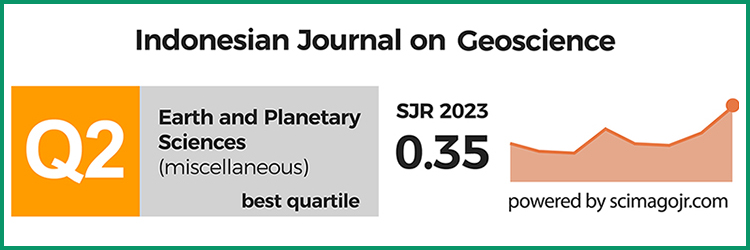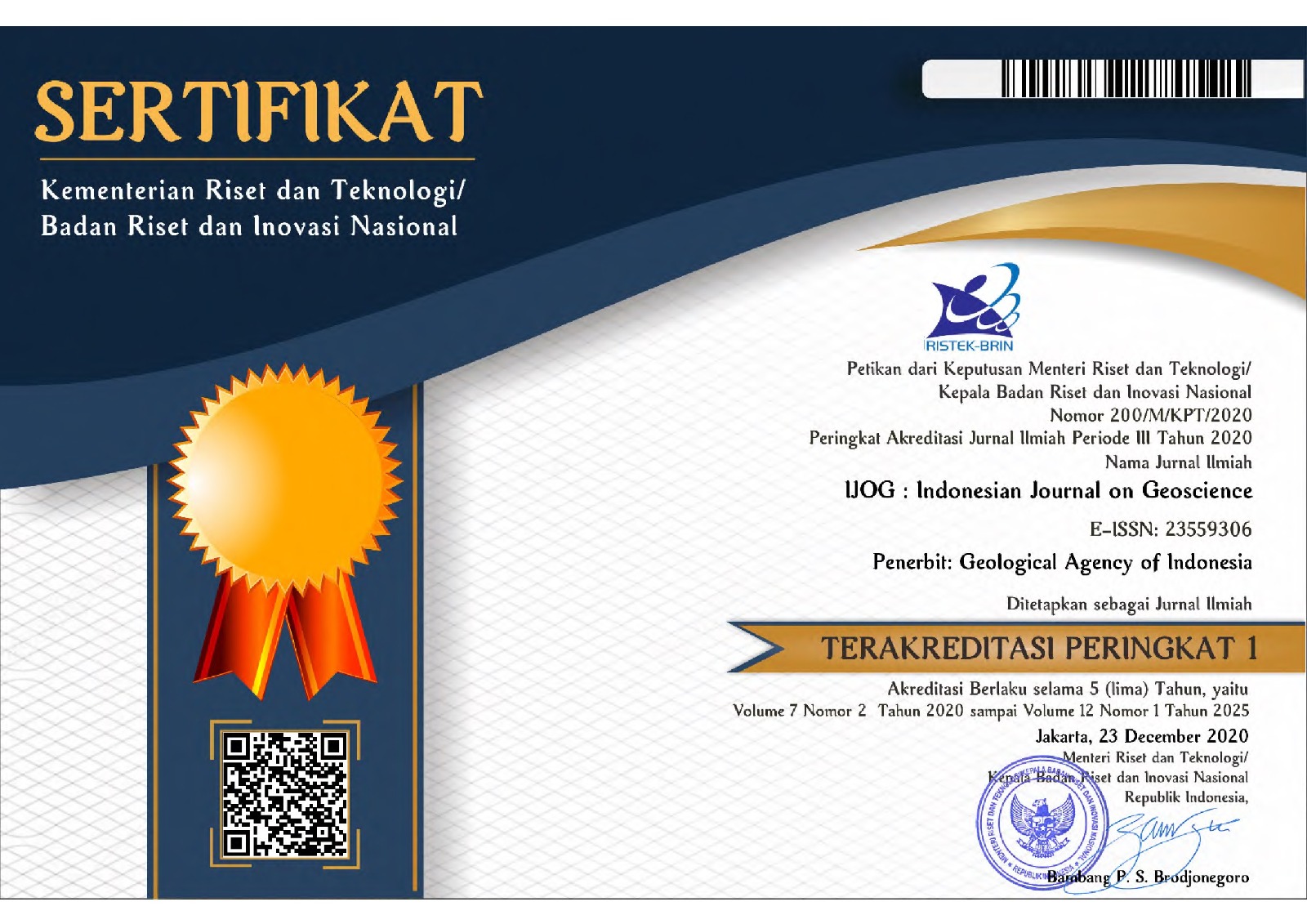Multi-geohazards of Ende city area
DOI:
https://doi.org/10.17014/ijog.2.4.217-233Keywords:
debris flow, rock-fall, pyroclastic flow, landslide, tsunami, liquefactionAbstract
https://dx.doi.org/10.17014/ijog.vol2no4.20073
The Ende City is a steep mountainous area, of which the height of their peaks are above 1500 m asl. It has the limited extent of plain places, without coastal plains. Due to this condition, large parts of the area are vulnerable to mass-movements mainly debris flows, rock-falls and shallow translational and rotational landslides. On the other hand, Flores Island is a segment of the Banda Arc that contains eleven very active volcanoes and numerous inactive volcanic cones. Two of them, Mount Iya and Mount Kelimutu are included to Ende Regency. The northern foot of Mount Iya is only about 1 km away from the southern outskirts of Ende city. But the presence of Mount Meja and Mount Roja as the barrier, and the orientation of the active crater (K2), the highly explosive eruption of Iya Volcano may not directly endanger the city of Ende. Most pyroclastic flows of previous eruptions and other eruptive material emplaced into the sea, but due to a short horizontal distance between Mount Iya and Ende City, the ejected rock fragments can endanger the city of Ende especially its southern parts. A crack has developed around the active crater (K2) of Iya Volcano. It seems that the crack indicates a major weakness within the volcano, which could result in a giant landslide, entering the sea in future eruptions of Iya Volcano. The kinetic energy which is transmitted through the water may probably generate a tsunami. The Ende City also experienced significant damages in the 1992 earthquake. Luckily this city is located on a solid rock instead of alluvial sediments which can potentially undergo liquefaction.
References
Audley-Charles, M.G., 1975. The Sumba fracture; a major discontinuity between eastern and western Indonesia. Tectonophysics, 26, p.213-228.
BPS (Badan Pusat Statistik) Kabupaten Ende, 2002. Ende Dalam Angka 2001. Ende.
Bryant, E.A., 2001. Tsunami. The underrated hazard. New York.
DPU – ITB (Departemen Pekerjaan Umum Republik Indonesia dan Institut Teknologi Bandung), 1994. Spatial planning for the island of Flores. Bandung.
DPU (Departemen Pekerjaan Umum) Republik Indonesia, 1994. Data survai untuk petunjuk umum perbaikan kerusakan akibat gempabumi. Bandung.
Effendi, W. and Chaniago, R., 1998. Geologi foto Gunungapi Rokatenda, Kabupaten Sikka, Propinsi NTT. Direktorat Vulkanologi dan Mitigasi Bencana Geologi. Bandung.
Hamilton, W., 1978. Tectonic map of the Indonesian region 1:5,000,000. Map I-875-D, US Geological Survey.
Hatherton, T., and Dickinson, W.R., 1969. The relationship between andesitic volcanism and seismicity in Indonesia, the Lesser Antilles and other island arcs. Journal of Geophysical Research, 74, p.5301-5310.
Issacks, B., Oliver, J., and Sykes, L., 1968. Seismology and the new global tectonics. Journal of Geophysical Research, 73, p.5855-5899.
Kasturian, P. and Wirasaputra, A.D., 1981. Pemeriksaan puncak dan pemetaan daerah bahaya G. Rokatenda. Field Report. Direktorat Vulkanologi, Bandung.
Katilli, J.A., 1973. Geochronology of west Indonesia and its implication on plate tectonics. Tectonophysics, 19, p.195-212.
Kertapati, E.K., 2001. Seimic Hazard Map of Indonesia. Geological Research and Development Centre. Bandung.
Kusumadinata, K., 1979. Data dasar gunungapi Indonesia. Catalogue of references on Indonesian volcanoes with eruptions in historical time. Direktorat Vulkanologi.
Matsutomi, 1992. Flores Island, Indonesia Earthquake of December 12, 1992. JICA Preliminary Investigation and Recommendations.
Neumann van Padang, N.M., 1930. Tidal waves during Rokatenda volcano eruption, Paluweh island in 1928.
Reksowirogo, L.D., 1969. Komunike G. Iya I-III. Direktorat Geologi.
Sclater, J.G., and Fisher, R.L., 1974. Evolution of the east central Indian Ocean, with emphasis on the tectonic setting of the Ninety East Ridge. Geological Society of America, Bulletin, 85, p.683-702.
Stehn, Ch.E., 1940. Vulkanologische onderzoekingen in Oost Flores. Vulkanologie & Seismik Mededeelingen, Batavia, 13, p.68-82.
Sumailani, A.R., and Sihat, E., 1985, Pemetaan situasi puncak G. Rokatenda, Pulau Palue, Kabupaten Sikka, Flores Tengah, Nusa Tenggara Timur. Field Report. Direktorat Vulkanologi dan Mitigasi Bencana Geologi. Bandung.
Sutawidjaja, I.S., Pribadi, A., and Taufiqurrohman, R., 2000. Pemetaan Geologi Gunungapi Rokatenda, Kabupaten Sikka, Nusa Tenggara Timur. Field Report. Direktorat Vulkanologi dan Mitigasi Bencana Geologi. Bandung.
Suwarna, N., Santosa, S., and Koesoemadinata, P., 1990. Geology of the Ende Quadrangle, East Nusa Tenggara 1:250,000. Geological Research and Development Centre, Bandung.
Takahashi, T., 2000. Initiation and flow of various types of debris flow. In: Wieczorek & Naeser (eds) Debris Flow Hazards Mitigation. Mechanics, Prediction and Assessment. Balkema, Rotterdam.
Weischet, W., and Endlicher, W., 2000. Reginale Klimatologie
– Die Alte Welt. Stuttgart, Leipzig.



















